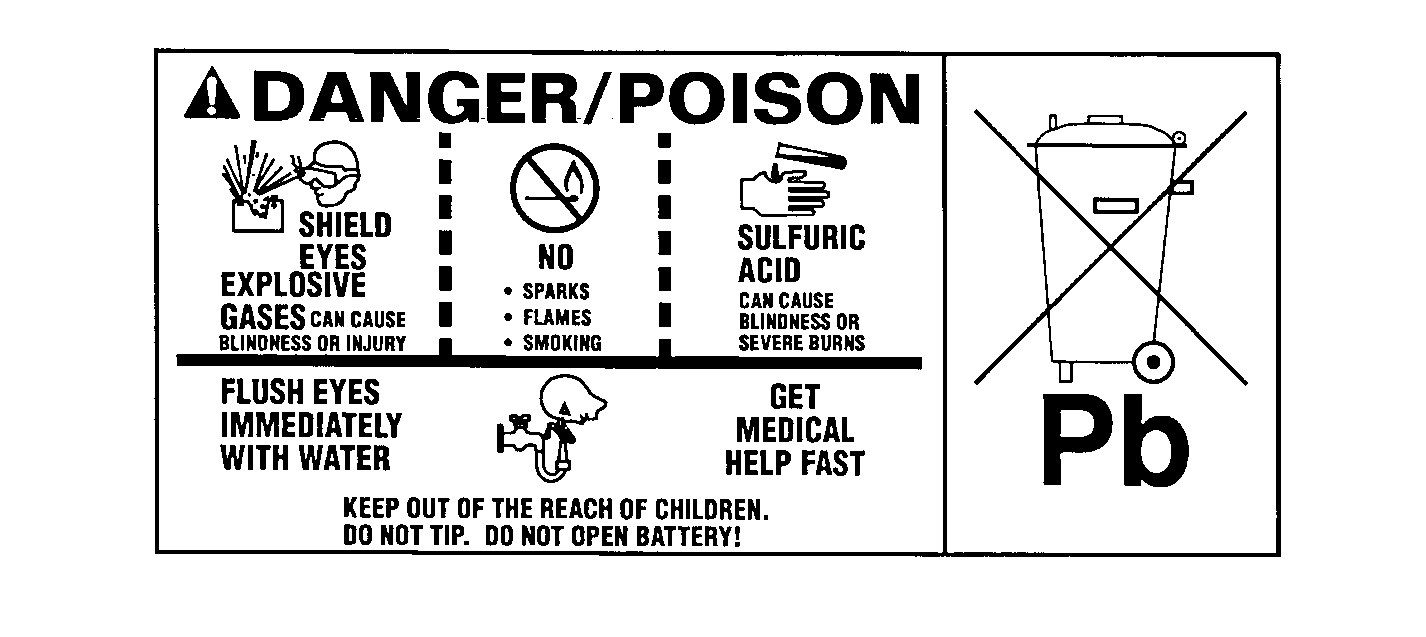Caution: Batteries produce explosive gases, contain corrosive acid, and supply levels
of electrical current high enough to cause burns. Therefore, to reduce the risk of
personal injury when working near a battery:
• Always shield your eyes and avoid leaning over the battery whenever possible. • Do not expose the battery to open flames or sparks. • Do not allow the battery electrolyte to contact the eyes or the skin.
Flush immediately and thoroughly any contacted areas with water and get medical help. • Follow each step of the jump starting procedure in order. • Treat both the booster and the discharged batteries carefully when using
the jumper cables.

The maintenance-free battery is the standard original equipment battery. There are no vent plugs in the cover. The maintenance-free battery is completely sealed except for two small vent holes in the side. These vent holes release the small amount of gas that is produced in the battery.
The battery has three functions as a major source of energy:
| • | Engine cranking |
| • | Voltage stabilization |
| • | An alternate source of energy with a generator overload. |
The battery specification label contains the following:
| • | The test ratings |
| • | The original equipment catalog number |
| • | The recommended replacement model number |

Battery Ratings
A battery has 2 ratings:
| • | Reserve capacity |
| • | Cold cranking amperage |
When a battery is replaced, use a battery with similar ratings. Refer to the battery specification label on the original battery or refer to Battery Usage .
Reserve Capacity
Reserve capacity is the time in minutes necessary to discharge a completely charged battery to a terminal voltage of 10.5 volts under the following conditions:
| • | A constant rate of 25 amperes |
| • | A constant temperature of 27°C (80°F) |
Refer to Battery Usage for the reserve capacity rating of the original equipment battery.
Cold Cranking Amperage
The cold cranking amperage is an indication of the ability of the battery to crank the engine at cold temperatures. The cold cranking amperage is the minimum amperage necessary to maintain 7.2 volts for 30 seconds at -18°C (0°F). Refer to Battery Usage for the cold cranking amperage rating for this vehicle.
Auxiliary Battery
Auxiliary batteries are an available option on vehicles where many accessories can be utilized such as TVs, radios, lights, computers, etc. The charging of these batteries is explained in charging system description and operation. Also, the auxiliary battery is only for accessory use and not part of the starting system.
Battery Description and Operation 12V and 24V
Caution: Batteries produce explosive gases. Batteries contain corrosive acid.
Batteries supply levels of electrical current high enough to cause burns.
Therefore, in order to reduce the risk of personal injury while working
near a battery, observe the following guidelines:
• Always shield your eyes. • Avoid leaning over the battery whenever possible. • Do not expose the battery to open flames or sparks. • Do not allow battery acid to contact the eyes or the skin. - Flush any contacted areas with water immediately and thoroughly. - Get medical help.
The engine electrical options include the slave receptacle, 24V generator, and a three-battery power system. The two batteries in series provide 24V of power. The 24V battery is located in the left front of the engine compartment. This will provide greater power for the higher load used by optional radio communications, or for compatibility with other slave receptacles on similarly equipped vehicles.
The LSSV vehicles are equipped with Optima batteries. The Optima battery is a sealed, zero-maintenance battery. Periodically inspect your battery terminal connections to ensure they are clean, tighten to the specified torque, and protected from the elements. The Optima battery require a special charging procedure. When charged properly you will not have to worry about leaking, corrosion or gassing. Refer to Battery Charging procedure.
Battery Storage
Because of Optima's high purity lead grid, it has a self discharge rate much lower than conventional flat plate batteries. This means the Optima can sit for longer periods retaining enough charge to start your vehicle. The vehicle load disconnect switch must be in the OFF position anytime the expected vehicle storage time is to exceed 10 days.
When possible, store your battery in a cool, dry location. Check the battery voltage every 6 months and charge if it falls below 12.6 volts. If the vehicle is to be stored for long periods you should use a maintenance charger to compensate for this drain. This charger should be voltage regulated between 13.2 - 13.8 volts, 1 amp maximum.
